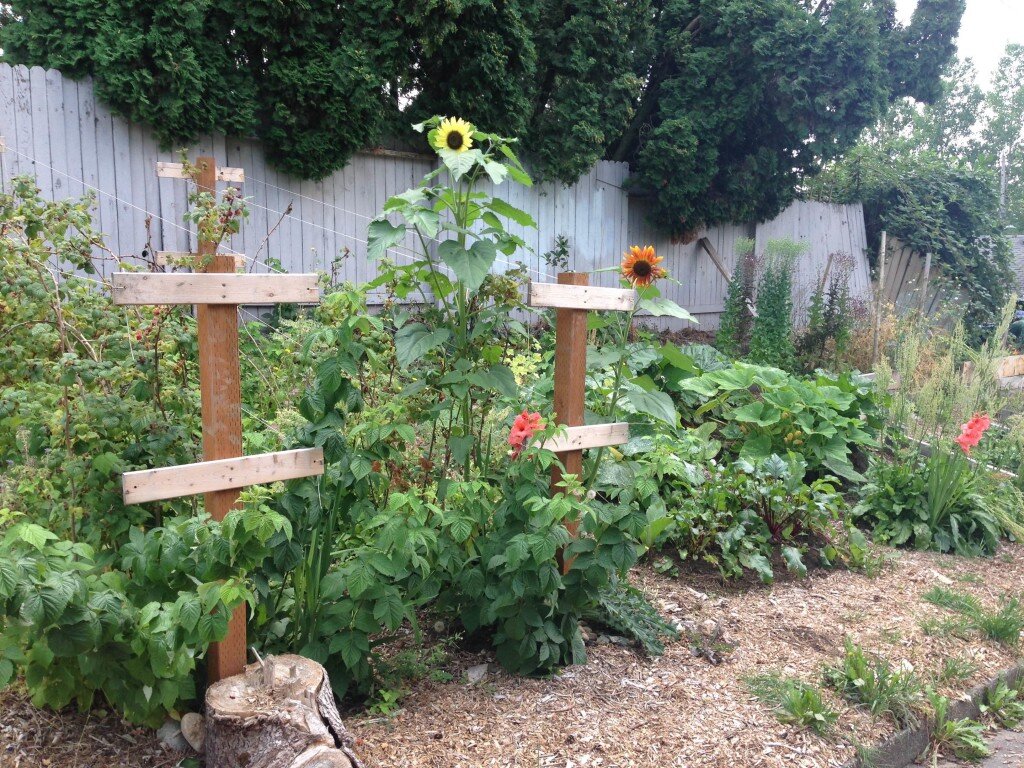A Cautionary Tale of Urban Gardening in Seattle
The city wants to tear up my garden.
By garden, I actually mean a young, thriving food forest. It’s so much more than annual vegetables. Rising up from the street, the terraced slope laced by wood-chipped paths explodes in a colorful array of raspberries, elderberries, currants, aronia berries, salal, strawberries, blueberries, and rhubarb. Mixed in, smaller beds of kale, summer squash, peas, and sunflowers make a brave stand in the varied terrain. Birds swoop in for kale seeds and bees buzz cheerfully amongst the borage flowers.
A year-and-a-half ago, this is what our side-yard looked like:
(When I say ‘our,’ I mean my six house-mates and I, members of a collective house in N. Seattle. I’m the so-called ‘garden czar’).
The side-yard had been abandoned as long as anyone could remember. Around the time I moved in, some housemates installed two raised-beds, but the rest of the area was still a depressing mess of weeds. It bothered our neighbors, and they often pestered us to fix it up.
In the spring of 2014, I had finally finished re-landscaping the backyard, so I took it upon myself to beautify the side-yard with the help of my housemates (our landlords are uninvolved in the property management). Given the City of Seattle’s recent support of urban food-production and gardening in planting strips, we figured we were doing our civic duty by joining the proud ranks of urban farmers. Additionally, we were excited to finally grow more food (our lot is heavily shaded, and even though the strip of land was on the North side of the house, it offered the best possibilities for gardening).
Fast-forward several months of back-bending labor in the cold and rain, moving earth, weeding out crab grass by hand, re-shaping beds, mixing compost…and by spring, the side-yard had been transformed:
Now, one spring later, my baby plants have grown and thrown up new shoots, and the bounty is pouring in:
But, in three weeks, the city will be sending in contractors to dig up the entire area, put in a retaining wall in place of the slope, and install a sidewalk with a planting strip for new street trees.
I’ve worked in agriculture and the urban food movement for years, and I’ve always encouraged gardeners to utilize public land for growing food, especially planting strips now that the city is on board. But with this impending project, my foundation of belief and conviction has been shaken.
What kind of city do we live in, that a set of code will be blindly enforced to the point of carving away three trees and a creative, bounteous edible landscape, so that two new trees can be planted in their place in a sterile, homogenous grid?
What kind of city do we live in that a creative, educational, beautifying garden will be sacrificed because of inflexible bureaucracy? The SDOT’s insistence that a new sidewalk must be on this side of the street (not the opposite, where nothing grows), and must be 8’ wide because of new code (cannot be narrower to mold to the existing garden), and that the project must take place in July (no flexibility for a different, cooler month, when the plants could be dug up and preserved)?
I am from Seattle, and I love this city. But I am watching the place I knew and loved disappear under new development that homogenizes: removing or ‘standardizing’ greenery and stifling the creative design inputs of its residents. The Capitol Hill of my childhood – characterized by charming brick apartments, craftsmen homes, and lush greenery – is quickly disappearing behind the mass of looming, artificial, modern condos. And South Lake Union – need I say more than, ‘what happened!’ Ballard was a charming fishing-village, affordable to the working class. Though I applaud the burgeoning new businesses, recent development has marred the charm and character, while simultaneously skyrocketing prices.
I recognize the need for sidewalks, and safety for children. I recognize the need for urban density, and sustainable design. But at what cost, morally and otherwise? Is there not a middle path?
This project is about so much more than my little garden. It is about what kind of city we want to live in, and on what kind of street, and with what kind of stake and investment in our land. It is about who can afford to live in this city, and where, and how?
It is about a proud Seattleite, avid gardener and struggling artist, watching homogenous development, rising prices, and changing values slowly push her out of her little green paradise.
It is about an urban gardener who thought the city was ready to make urban food production a priority–with the required flexibility, dedication, and services to protect and support urban gardens—and found that at least in her case, it was not true.
In three weeks, my garden may be reduced to a pile of rubble and splintered wood. But I hope that it will not be destroyed in vain, and that this story of ‘the little urban food forest that could’ can serve as an example: warning would-be urban farmers of the potential threats to their projects, and hopefully encouraging the city to set up policy that truly protects and encourages the farming efforts of its citizens.
Urban food production and urban development do not need to be in competition. Ideally, they should be one and the same.
Please share this story on social media and share your comments below.





